Picture this: your team is dispersed across different time zones, working on multiple projects. Deadlines are looming, but you can’t see how much time tasks are taking, or if employees are overworked. In a world where remote and hybrid work are the norm, understanding employee productivity is crucial. The right time tracker helps track time, monitor workflows, and provides data-driven insights to optimize performance. In this definitive guide, we explore the best software for tracking employee productivity and time. We’ll break down features, use cases, pros and cons, and show how Everhour fits naturally into this landscape to boost productivity.
What Is Employee Productivity Tracking Software?
Employee productivity tracking software helps organizations see how work gets done—covering hours, tasks, and efficiency. It gives managers insights to:
- ⏱️ Log hours worked and tasks completed
- 📊 Understand how employees spend their time
- ⚡ Spot bottlenecks and improve workflows
- 🤝 Ensure accountability without micromanaging
- ✅ Stay compliant with labor regulations
Generally, these tools fall into two categories:
- Time tracking software ⏰ – Focused on recording hours spent on tasks and projects. Useful for payroll, billing, and accurate budgeting.
- Employee monitoring software 🖥️ – Tracks apps used, websites visited, and sometimes screenshots. Offers detailed analytics on productivity patterns.
In this article, we’ll highlight tools that strike a balance—helping teams track time and tasks effectively, while still respecting privacy and employee autonomy.
Top Software for Tracking Employee Productivity
Based on research (including People Managing People’s recommendations and top Google results), here are the leading tools of the time tracking software market:
- Everhour
- Toggl Track
- Hubstaff
- Time Doctor
- ActivTrak
- ClickTime
- Harvest
- RescueTime
- TimeCamp
- Clockify
Below, we detail each tool’s features, pricing, pros and cons, and best use cases.
1. Everhour
Everhour is a time tracking tool designed for teams working across multiple projects. It integrates with popular project management apps like Asana, Trello, and ClickUp. Everhour emphasizes accurate time logging, budgets, and reporting.
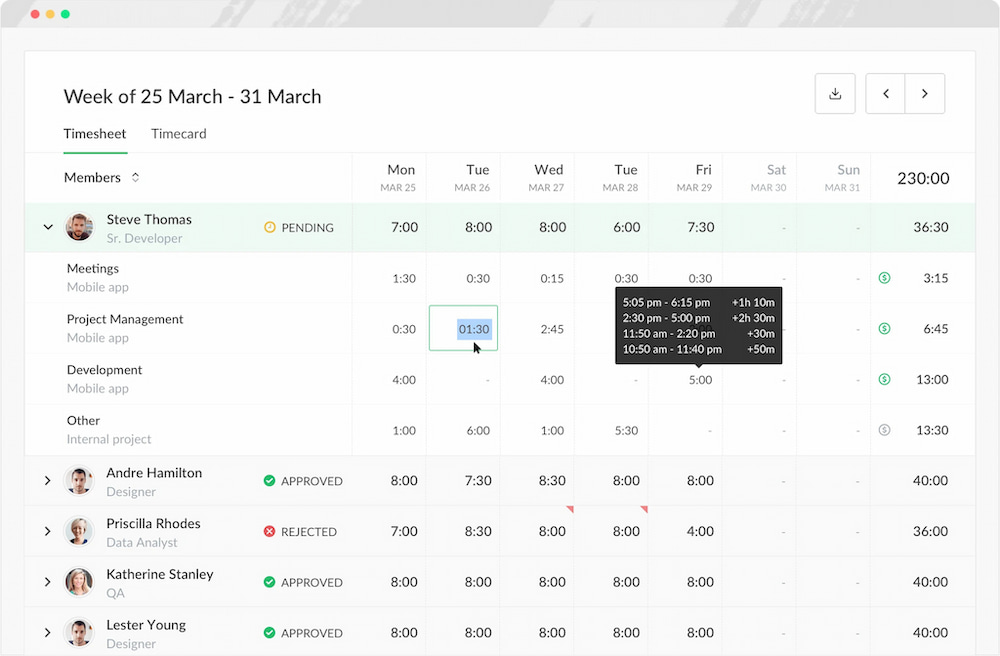
🧠 Key features
- Time tracking: Start/stop timers or log time manually. Track time by project, task, and team member.
- Estimates vs. actual: Compare estimated hours with actual time to improve planning.
- Budgeting & alerts: Set budgets for projects or tasks. Get alerts when nearing or exceeding budgets.
- Reporting: Generate reports on time spent, billable hours, and team utilization.
- Invoicing & payroll: Create invoices based on time entries. Export timesheets for payroll.
- Integrations: Connect with Asana, ClickUp, Trello, Basecamp, GitHub, Notion, and more.
- Permissions & approvals: Set user roles; managers approve or edit time entries.
💰 Pricing
- Free plan (limited features)
- Team plan ($10/user/month) adds advanced features like budgets, approvals, and invoicing
✅ Pros
- Integrates seamlessly with existing project management tools.
- Detailed reporting and budgeting.
- Simple interface; easy adoption.
❌ Cons
- No screenshots or productivity monitoring beyond time tracking.
- Dependent on integrations for full context.
Ideal for: Agencies, consultancies, freelancers, and project-based teams needing detailed time tracking and budgets.
2. Toggl Track
Toggl Track is a user-friendly time tracker. It’s known for its one-click timer and simple interface. Toggl offers reports, budgets, and an offline mode.
![11+ timesheet apps for any need [updated for 2021]](https://blog-cdn.everhour.com/blog/wp-content/uploads/2021/06/toggl-timesheet-app.png)
🧠 Key features
- One-click timers with reminders.
- Billable and non-billable labeling.
- Time estimates and alerts.
- Reports for employees and clients.
- Project and team dashboards.
- Over 100 integrations.
💰 Pricing
- Free plan for up to five users.
- Starter (~$10/user/month) adds reporting and multiple currencies.
- Premium (~$20/user/month) provides time rounding and reminders.
- Enterprise custom pricing.
✅ Pros
- Easy to use.
- Excellent for freelancers and small teams.
- Powerful integrations.
❌ Cons
- Lacks detailed productivity monitoring.
- Limited features on the free plan.
Ideal for: Freelancers, consultants, small businesses.
3. Hubstaff
Hubstaff combines time tracking with activity monitoring, making it popular for remote teams. It includes screenshots, app/URL tracking, and productivity reports.
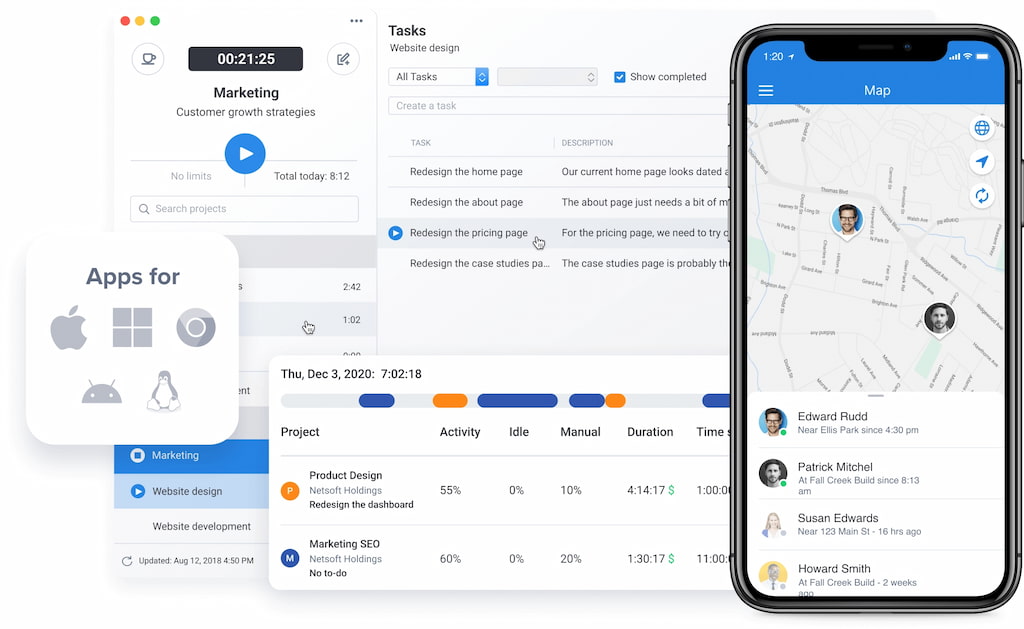
🧠 Key features
- Time tracking via desktop, mobile, and Chrome extension.
- Activity levels based on mouse/keyboard usage.
- Screenshots (optional) to see work progress.
- GPS and geofencing for location-based tracking.
- Payroll integration with PayPal, Payoneer, and Gusto.
- Invoicing and expense tracking.
- Integrations with project management tools.
💰 Pricing
- Free for one user (time tracking only).
- Basic (~$7/user/month): time tracking, activity levels, and reports.
- Premium (~$10/user/month): adds app/URL tracking, payroll, invoices.
- Enterprise custom pricing.
✅ Pros
- Detailed productivity metrics.
- Excellent for remote team management.
- GPS and geofencing.
❌ Cons
- Screenshots and activity tracking may raise privacy concerns.
- Requires training for proper use.
Ideal for: Remote teams, field employees, businesses that need location and activity monitoring.
4. Time Doctor
Time Doctor focuses on productivity monitoring along with time tracking. It captures screenshots, monitors website/app usage, and provides distraction alerts.
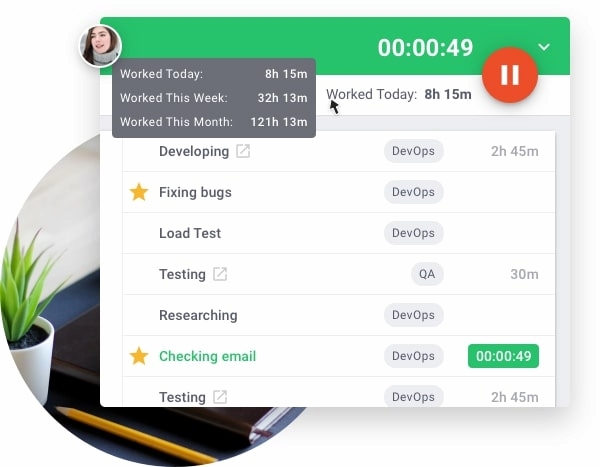
🧠 Key features
- Time tracking with desktop and mobile apps.
- Website/app usage monitoring with distraction notifications.
- Screenshots (configurable frequency).
- Payroll and invoicing integration.
- Detailed reporting (tasks, clients, departments).
- Flexible for remote and office productivity.
💰 Pricing
- Basic (~$7/user/month): time tracking, tasks, reports.
- Standard (~$10/user/month): adds client login, payroll, screenshot capture, custom fields.
- Premium (~$20/user/month): advanced reporting and unlimited teams.
✅ Pros
- Helps identify distractions.
- Tracks websites/apps.
- Suitable for agencies and call centers.
❌ Cons
- Some employees may find monitoring intrusive.
- Requires training to interpret activity data fairly.
Ideal for: Businesses requiring accountability and distraction monitoring.
Learn more about Time Doctor and Hubstaff in our Time Doctor vs Hubstaff breakdown!
5. ActivTrak
ActivTrak is an employee monitoring tool focusing on productivity analytics. It gathers granular data on application usage, websites, and patterns to identify productive and unproductive behavior.
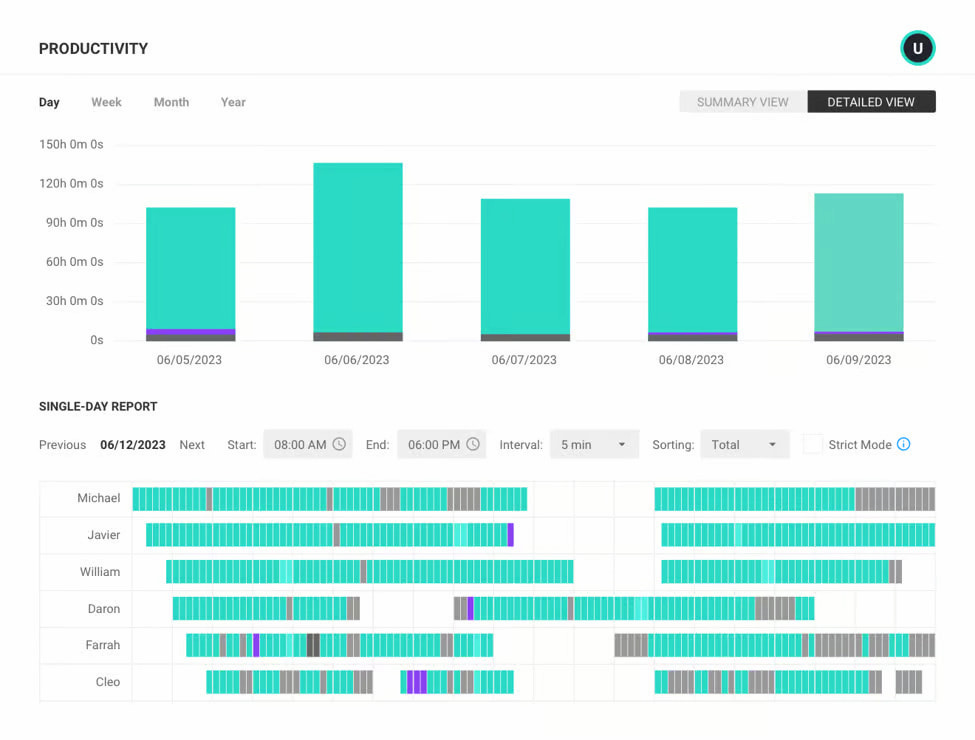
🧠 Key features
- Activity tracking (websites, apps, idle/active time).
- Productivity labeling (productive, unproductive).
- Real-time monitoring.
- Automatic alerts for policy violations.
- Productivity coaching and benchmarking.
- Integrations with Slack, Jira, and others.
💰 Pricing
- Free version for 3 users.
- Advanced (~$9/user/month): includes productivity reports and analytics.
- Premium custom pricing.
✅ Pros
- Rich productivity analytics.
- Helps identify training needs.
- Privacy-sensitive settings (masking information).
❌ Cons
- Does not include project management.
- Focus on computer activity, not time entries.
Ideal for: Managers wanting deep insights into work patterns and productivity.
6. ClickTime
ClickTime offers time tracking, expense tracking, and resource planning. It’s geared towards project-based organizations with budgets and job costing.
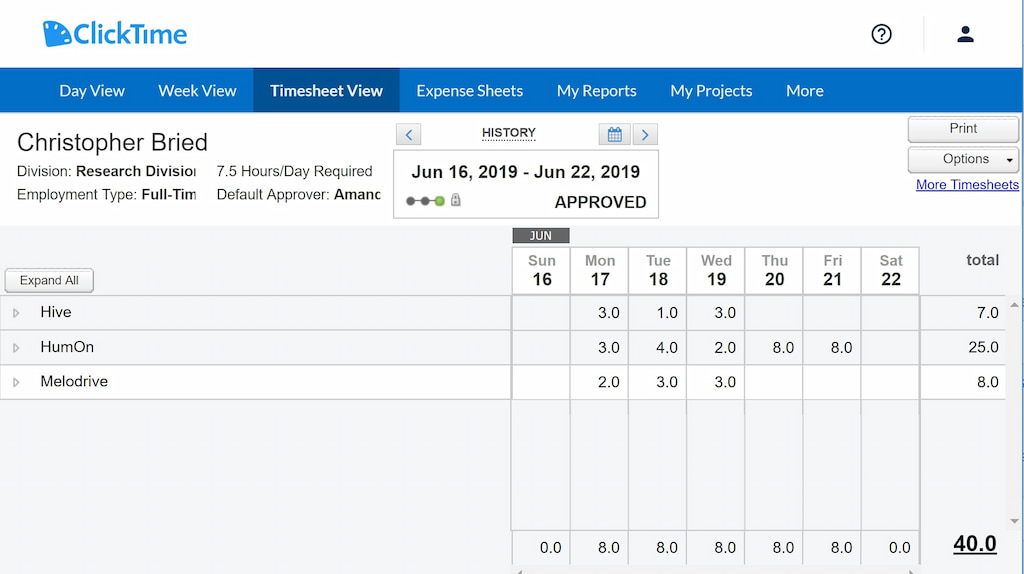
🧠 Key features
- Timesheets with tasks and projects.
- Expense management and budgets.
- Resource planning and capacity management.
- Reporting and dashboards.
- Integrations with QuickBooks, Salesforce, and project management tools.
💰 Pricing
- Starter (~$10/user/month) for timesheets and reporting.
- Team (~$15/user/month) adds advanced reporting.
- Premier (~$23/user/month) adds resource planning and expense tracking.
✅ Pros
- Accurate budgeting and resource planning.
- Suitable for consulting firms and agencies.
- Integrates with accounting.
❌ Cons
- Complex features may require training.
- Not a full employee monitoring system.
Ideal for: Agencies, consultants, professional services firms needing budgeting.
7. Harvest
Harvest is a time tracking and invoicing tool. It’s popular among freelancers and small teams needing simple tracking and invoicing.
![11+ timesheet apps for any need [updated for 2021]](https://blog-cdn.everhour.com/blog/wp-content/uploads/2021/06/harvest-timesheet-app.png)
🧠 Key features
- Time tracking across projects and tasks.
- Invoicing and payments via Stripe and PayPal.
- Expenses and budgeting.
- Scheduling via Harvest Forecast (separate product).
- Integrations with Trello, Asana, and Slack.
💰 Pricing
- Free for one seat and two projects.
- Pro ($12/user/month) for unlimited projects.
- Forecast: separate pricing at $5/user/month.
✅ Pros
- Simple to use.
- Combined time tracking and invoicing.
- Powerful integrations.
❌ Cons
- Limited features in the free plan.
- Forecasting requires a separate purchase.
Ideal for: Freelancers, small agencies, and teams billing clients.
8. RescueTime
RescueTime is a productivity analytics tool rather than a timesheet tracker. It monitors computer usage to help users understand how they spend their time.
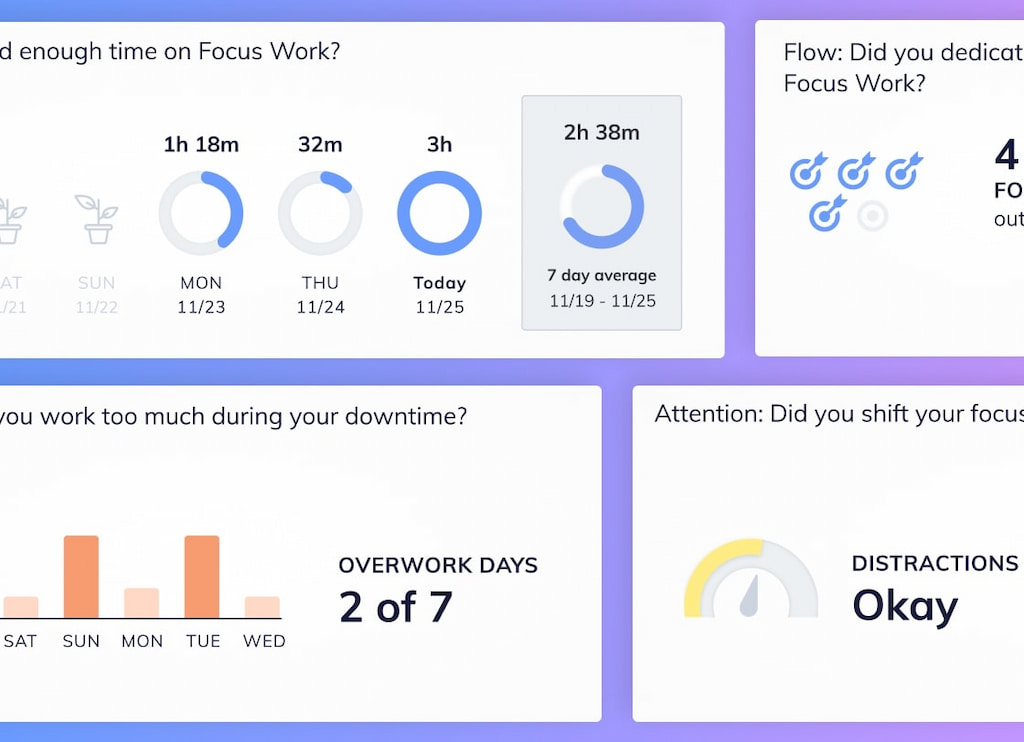
🧠 Key features
- Automatic tracking of applications, websites, and activities.
- Productivity scoring (productive vs. distracting).
- Daily, weekly, monthly reports.
- Focus sessions (distraction blocking).
- Goal setting and alerts.
💰 Pricing
- Free Lite plan.
- Premium (~$12/month) for full reports and focus tools.
- Team plans available.
✅ Pros
- Automatic; no manual timer needed.
- Helps individuals understand and improve habits.
- Useful for remote teams and individual productivity.
❌ Cons
- No project or client-level time entries.
- Could be seen as intrusive by employees.
Ideal for: Individuals and teams wanting insights into productivity patterns without manual tracking.
9. TimeCamp
TimeCamp offers time tracking, invoicing, attendance tracking, and productivity monitoring. It’s used by freelancers, teams, and enterprises.
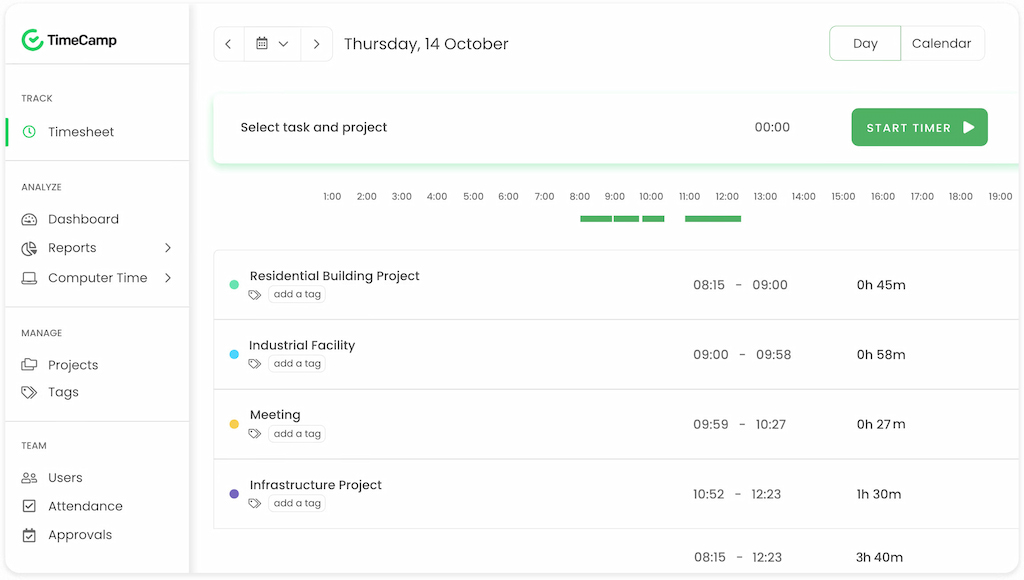
🧠 Key features
- One-click timers and manual entries.
- Task-based tracking with projects and subtasks.
- Productivity and idle time monitoring.
- Attendance tracking with clock-in/out.
- Reports: timesheets, budgets, and profitability.
- Integrations with Trello, Asana, Basecamp, Slack.
💰 Pricing
- Free plan for single users.
- Basic ($3.99/user/month) for small teams.
- Pro ($5.99/user/month) adds productivity tracking and reporting.
- Enterprise custom pricing.
✅ Pros
- Affordable plans with productivity and time tracking.
- Flexible reporting.
- Idle time and productivity monitoring.
❌ Cons
- Interface could be more intuitive.
- Setup may take some time.
Ideal for: Small to mid-sized teams needing time and productivity tracking.
10. Clockify
Clockify provides free time tracking for unlimited users. It offers features beyond basic tracking, including timesheet approvals and payroll.
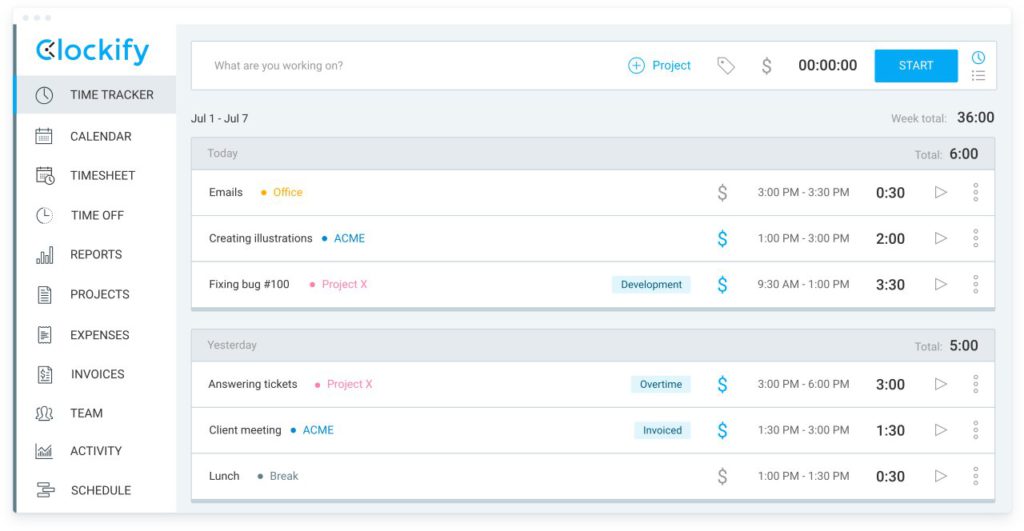
🧠 Key features
- Unlimited users and projects on the free plan.
- Timers, timesheets, and manual entries.
- Reports and dashboards.
- GPS tracking on mobile.
- Integrations with Trello, Asana, Jira, and QuickBooks.
💰 Pricing
- Free: time tracking and reports.
- Basic ($4.99/user/month) for time rounding and control.
- Standard ($6.99/user/month) adds billing rates and invoicing.
- Pro ($9.99/user/month) includes labor cost and scheduling.
✅ Pros
- Generous free tier.
- Simple interface and quick setup.
- Modular upgrades.
❌ Cons
- No deep productivity analysis; mostly time tracking.
- Limited features compared to full workforce platforms.
Ideal for: Teams needing cost-effective time tracking.
How Everhour Fits Into Employee Productivity Tracking
Everhour works as a standalone time tracker or alongside tools like Asana, ClickUp, and Trello. It helps teams track time accurately and manage productivity efficiently.
✨ Key features:
- 🔗 Integrations: Track time directly within tasks on Asana, ClickUp, Trello, and other apps.
- 💰 Estimates & budgets: Compare estimated vs. actual time to prevent overruns.
- 📊 Reports & dashboards: Detailed breakdowns by task, project, client, or team member. Dashboards show where effort goes.
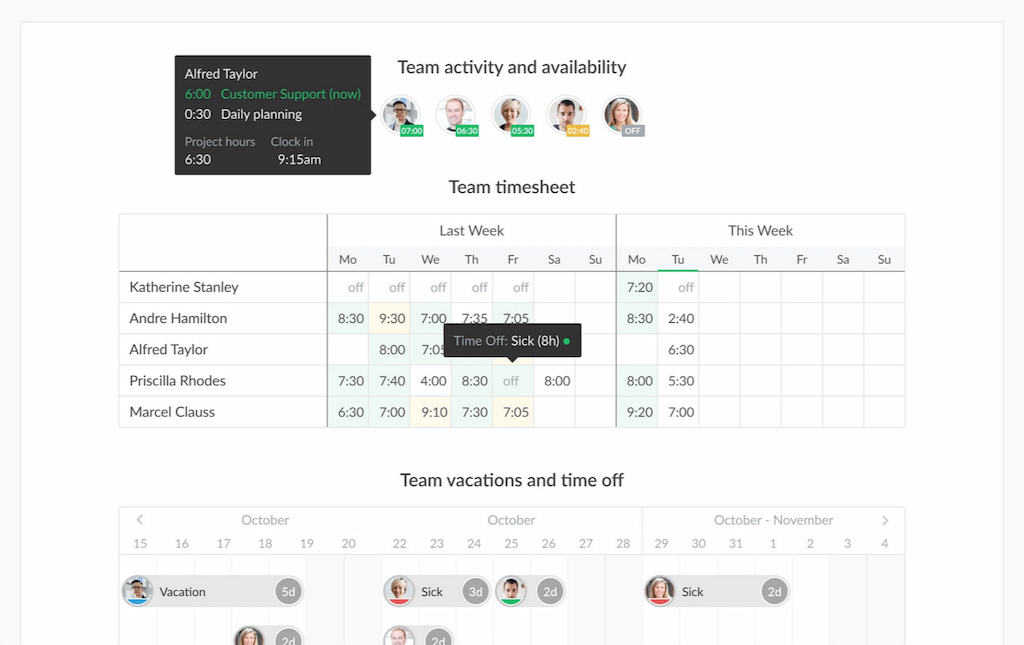
- ✅ Timesheet approvals: Managers can approve or edit entries for accountability.
- 🧾 Invoices & payroll: Generate invoices and export timesheets. Works with QuickBooks, Xero, and other accounting software.
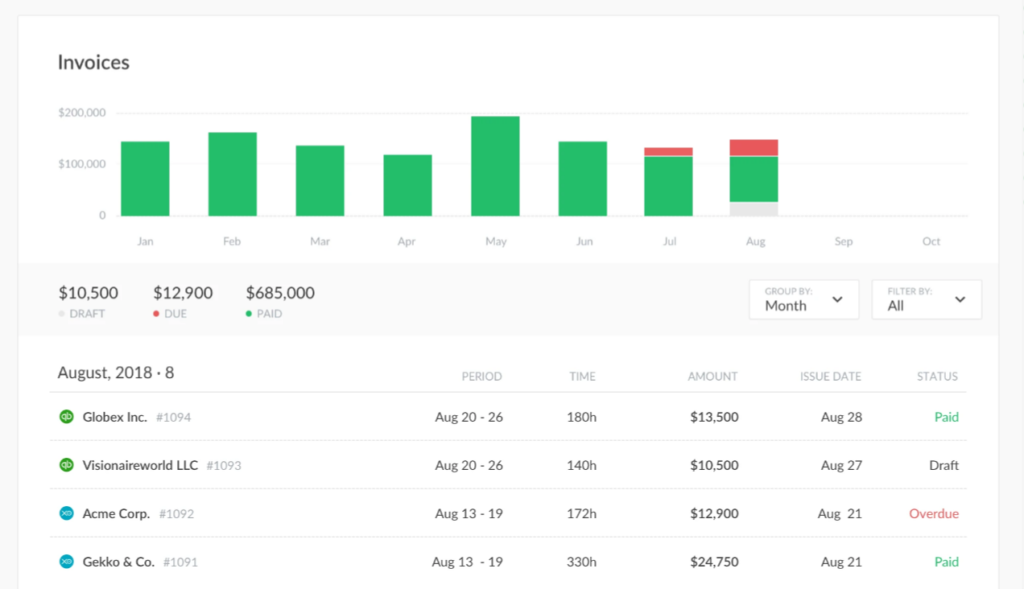
- ⏳ Flexible logging: Employees can log time via timers or manual entries.
💡 Use case example:
A digital agency manages tasks in Asana for designers and developers. Everhour adds timers to each task so staff track time directly in Asana. Reports highlight projects exceeding budgets, allowing managers to adjust plans or bill clients accurately. Result: improved profitability and no more guesswork on hours.
Tips & Best Practices for Employee Productivity Software
- 📌 Choose based on needs: Pick time tracking for billing or budgeting, and productivity monitoring for insights into work patterns.
- 🔒 Prioritize privacy: Be transparent about what you track, and use software that protects sensitive data.
- 🔗 Integrate with existing tools: Connect with project management, communication, HR, or accounting tools for a smooth workflow.
- 🌱 Start small: Begin with basic time tracking, then expand monitoring as the team adapts.
- 📊 Analyze and act: Regularly review reports to spot bottlenecks and improve processes.
- 🤝 Focus on outcomes, not micromanagement: Use software to support employees, not watch every action.
- 🎯 Set goals and budgets: Assign estimated hours to tasks and track progress to improve planning.
- ⚙️ Combine tools when needed: Use Everhour for tracking; add other software like ActivTrak for deeper insights if necessary.
- ✅ Check compliance: Ensure software follows labor laws and maintain proper records.
- 🔄 Reevaluate periodically: Assess whether tools still meet team needs and adjust as required.
FAQ
Is employee productivity tracking invasive?
It depends on the tool. Focus on time and task tracking rather than invasive monitoring, and be transparent with your team.
Do I need both time tracking and activity monitoring?
Not always. Time tracking is enough for billing or budgeting. Activity monitoring helps with workflow insights or compliance.
How does Everhour compare to Toggl?
Everhour integrates with project management tools and offers budgets and reports. Toggl is simple and works standalone.
Which tool is best for remote teams?
Hubstaff and Time Doctor provide activity monitoring, screenshots, GPS, and time tracking for accountability. Everhour works well with project management apps for remote teams.
What’s the difference between time tracking and productivity monitoring?
Time tracking measures how long tasks take. Productivity monitoring tracks activities (apps, websites) to gauge efficiency. Together, they give a full picture.
Can I export data to payroll?
Yes. Tools like Everhour, Hubstaff, and Time Doctor can export timesheets to payroll or accounting software.
Are free plans worth it?
Free plans are useful for testing but often limit users or projects. Upgrade for advanced features.
How do I choose between Everhour and ClickTime?
Everhour is best if you want time tracking integrated into project apps. ClickTime adds resource planning and expense tracking for better budgeting.
Does Everhour track websites and apps?
No. Everhour focuses on time tracking, budgeting, and reporting—it doesn’t monitor websites or take screenshots.
Is it legal to monitor employees?
Laws vary by region. Inform employees of the monitoring activity. Time tracking for payroll is usually legal; more invasive monitoring often requires consent.
Best Software for Tracking Employee Productivity: Final Thoughts
Productivity and time tracking tools help businesses see where time goes, balance workloads, and work more efficiently. There are many good options depending on your needs:
- Everhour: Best for teams using project management tools. Offers reports, budgets, and invoicing.
- Toggl: Simple tracker ideal for freelancers.
- Hubstaff & Time Doctor: Time tracking with monitoring features—useful for remote teams needing accountability.
- ActivTrak: Focused on analytics, showing how apps and websites are used.
- ClickTime, Harvest, TimeCamp, Clockify: Flexible choices combining tracking with expenses, resource planning, or invoicing.
The best productivity time tracking software should make work easier, not harder. Used responsibly, time tracking builds transparency and supports better teamwork. If you already manage projects with apps like Asana, Trello, or Todoist, Everhour adds seamless time tracking and reporting. Start with a free plan, test what works for your team, and grow from there.
Struggling with productivity and time management? Learn how to manage your time and prioritize tasks in our thorough guide!
Check out more about Time Doctor in our Time Doctor vs Clockify breakdown!

